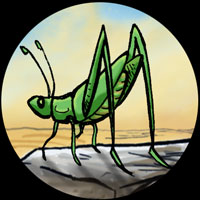About La Séptima Bala
- Read the online short story.
La Séptima Bala was written around 1998 (published online 2015). It was inspired by a Japanese girlfriend who grew up in Mexico, and who meditated; nonetheless all the characters (including the girl), events, and settings are fictional. The style of the language is a tip o’ the hat to Isabel Allende’s fabulous The Stories of Eva Luna (and specifically the English translation by Margaret Sayers Peden).
La Séptima Bala is a Beholder project:
- illustrations by René Carbonell
- words and coding by Dave Whiteland
- colouring by both of us
Thanks too to Jed for optimisation and Masayo for some fact-checking.
René and I worked on this together (in Bangkok) in November 2013 and intensively in December 2014; and online in some of the time in between and over into 2015 too. As it happens, René is Mexican, although he is neither from the time nor the region where this story is set.
There's now a blog post about the project over on the Fudebakublog. There are also some entries in the scrapbook.
The interactive storytelling here is a subtle kind of user training. For some readers it may engender a tiny sensation of surprise and brief confusion; a sensation that reflects that experienced by at least one character in the story. This can’t be done on paper in such a way. We hope you enjoy it.

Colophon
- Code: JavaScript using jQuery
- Animation: GreenSock
- Audio: lowLag and SoundManager2
- Original MP3 source: SoundJay
Right now, getting interactive sound (even optional interactive sound) to work across web browsers is much harder than it should be. The (minimal) audio that’s bound to a few clicks in La Séptima Bala will probably work OK on your browser (thanks to the lowLag library and Jed’s cross-browser patience). The story should work for you, even if there is no sound.
This work is licensed under a Creative Commons Attribution-NonCommercial-NoDerivatives 4.0 International License.
A note about Zen and archery
If you’ve encountered such mystic nonsense before, you probably recognised that La Séptima Bala is playing with the infamous platitude attributed to Japanese archery of “being one with the target.” Nowadays such archery is implicitly understood to be the formalised practice of kyudo, and if you know about that then you almost certainly know about its perceived overlap with metaphysical Zen. Of course such a martial topic isn’t entirely accidental — after all, the martial arts parody Fudebakudo is a Beholder project too.
The actual story of how Zen came to be so strongly associated with Japanese archery — because in terms of Zen’s long history it was, until recently, most certainly not — is a marvellous one, and has more than a shade of Fudebakudo about it. The strong association with Zen is due to the influential book Zen in the Art of Archery by German writer and visitor-to-Japan Eugen Herrigel, and his flawed understanding of what was actually going on. In short, there’s a convincing case to be made that the whole thing was a clumsy and needy bit of cultural single-mindedness combined with some sloppy thinking. Herrigel’s subsequent enthusiasm for the philosophy of the Nazi party suggests this wasn’t his only lapse of insight, either.
This remarkable tale is described in detail in the eminently readable paper The Myth of Zen in the Art of Archery by professor Yamada Shoji (Japanese Journal of Religious Studies, 2001). So if you spotted the uchiokoshi in La Séptima Bala (or just enjoyed the Zen stuff), I strongly recommend you read it — it really deserves to be better known. For more discussion around it, and to see some woefully broad-brush defending of the Zen position, see also this thread on e-Budo.
- Read the online short story.

